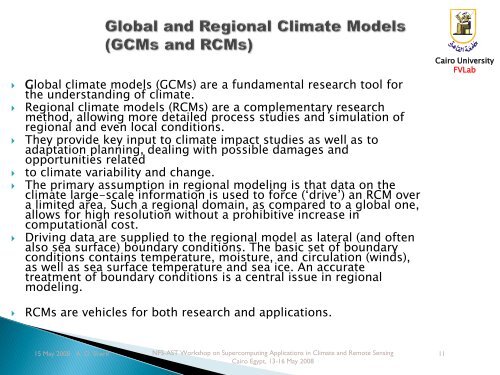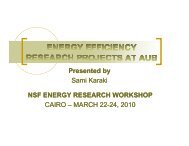Atef O. Sherif - CIMAP
Atef O. Sherif - CIMAP
Atef O. Sherif - CIMAP
You also want an ePaper? Increase the reach of your titles
YUMPU automatically turns print PDFs into web optimized ePapers that Google loves.
� Global climate models (GCMs) are a fundamental research tool for<br />
the understanding of climate.<br />
� Regional climate models (RCMs) are a complementary research<br />
method, allowing more detailed process studies and simulation of<br />
regional and even local conditions.<br />
� They provide key input to climate impact studies as well as to<br />
adaptation planning, dealing with possible damages and<br />
opportunities related<br />
� to climate variability and change.<br />
� The primary assumption in regional modeling is that data on the<br />
climate large-scale information is used to force („drive‟) an RCM over<br />
a limited area. Such a regional domain, as compared to a global one,<br />
allows for high resolution without a prohibitive increase in<br />
computational cost.<br />
� Driving data are supplied to the regional model as lateral (and often<br />
also sea surface) boundary conditions. The basic set of boundary<br />
conditions contains temperature, moisture, and circulation (winds),<br />
as well as sea surface temperature and sea ice. An accurate<br />
treatment of boundary conditions is a central issue in regional<br />
modeling.<br />
� RCMs are vehicles for both research and applications.<br />
15 May 2008 A. O. <strong>Sherif</strong><br />
NFS-AST Workshop on Supercomputing Applications in Climate and Remote Sensing<br />
Cairo Egypt, 13-16 May 2008<br />
Cairo University<br />
FVLab<br />
11





